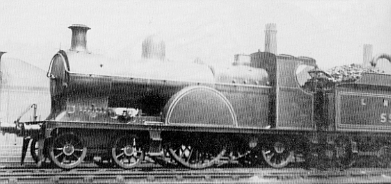The Pollitt X4 (GCR Class 13) 4-2-2 Singles

"Singles", locomotives with single driving axles, were a popular design for express passenger locomotives during the middle of the 19th Century. As train loads grew, they went out of fashion, but had a brief renaissance after steam sanding gear appeared in 1886. This renaissance ended around 1900 as train loads continued to grow, and virtually all had been withdrawn before Grouping in 1923. The only 4-2-2s to survive were the six X4s designed by Pollitt for the Great Central Railway (GCR).
The X4s (GCR Class 13) were the last locomotive type to be designed by Pollitt before his retirement. Indeed, only two had been built when Robinson took over. Introduced in 1900, the X4s were also the last of the 4-2-2 Singles. Robinson quickly cut the order from ten down to six, so he was probably well aware the 4-2-2 design was in decline.
The X4 design had a lot in common with Pollitt's D6. He also added a large grate of almost 25sq ft., and used a high boiler pressure of 200psi. The boiler pressure was quickly reduced to 160psi due to problems with slipping.
In 1911, Robinson rebuilt No. 969 with a larger boiler, but this was removed when a superheater was fitted in 1915. Between 1915 and 1919, four of the class (Nos. 967, 969, 970, and 972) had superheaters fitted. Nos. 968 and 971 kept their saturated boilers.
Originally built for the GCR's London Extension, they only worked this line until 1903 when they were replaced by Robinson D9s. All six locomotives were then moved to Cheshire, where they allocated for the rest of the lives. Despite some slipping problems, the X4s proved capable of handling the Cheshire express trains. Although all six survived into LNER ownership, they were of an outdated design and the LNER started withdrawals in December 1923. The last locomotive was withdrawn in 1927. The four superheated boilers were found to be in good condition, and these were kept as stationary boilers.
Technical Details
These details describe the superheated X4s at Grouping in 1923.
| Cylinders (x2): | 19.5x26in. | |
| Motion: | Stephenson | |
| Piston Valves: | 8.75in. diameter | |
| Boiler: | Max. Diameter: | 4ft 3in |
| Pressure: | 160psi | |
| Heating Surface: | Total: | 1043 sq.ft. |
| Firebox: | 128 sq.ft. | |
| Superheater: | 138 sq.ft. | |
| Tubes: | 490 sq.ft. (86x 1.875in) | |
| Flues: | 287 sq.ft. (18x 5.25in) | |
| Grate Area: | 24.8 sq.ft. | |
| Wheels: | Leading: | 3ft 6in |
| Coupled: | 7ft 9in | |
| Trailing: | 4ft 6in | |
| Tender: | 4ft 3in | |
| Tractive Effort: | 14,457lb | (@ 85% boiler pressure) |
| Length: | 54ft 9.25in | |
| Wheelbase: | Total | 45ft 5in |
| Engine: | 22ft 11in | |
| Tender: | 13ft 0in | |
| Weight (full): | Total: | 92 tons 17cwt |
| Engine: | 49 tons 17cwt | |
| Tender: | 43 tons 0cwt | |
| Max. Axle Load: | 18 tons 10cwt |
Preservation
The last X4 (No. 5927) was withdrawn in 1927. Although it took part in the Stockton & Darlington celebrations in 1925, it was not kept for preservation.
Models
I am not aware of any models of the X4s in any scale.